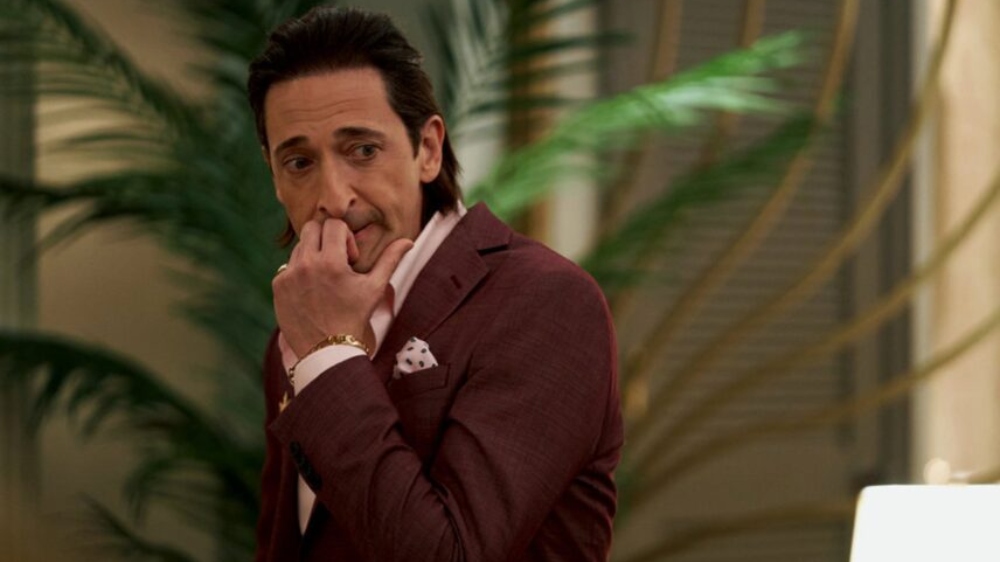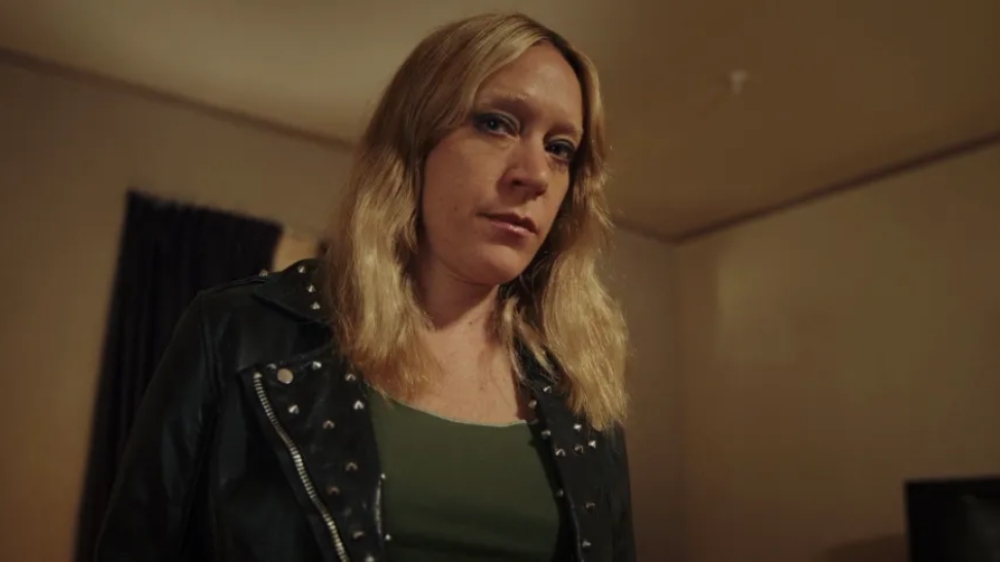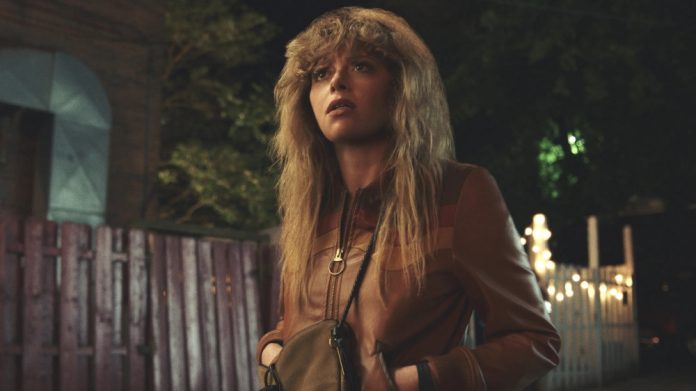When human lie detector Charlie Cale (Natasha Lyonne) figures out who committed a murder at a casino, she’s forced to go on the run in her Barracuda as she’s pursued across the country by relentless hitman Cliff LeGrand (Benjamin Bratt). Charlie may have great survival instincts herself, but she’s a harbinger of death, as she stumbles upon a new murder mystery in every episode. That’s the premise of Rian Johnson‘s delicious new series Poker Face, which is now streaming on Peacock.
With a fantastic cast of guest stars, Poker Face evokes the heyday of mystery shows like Columbo and The Rockford Files. Forced off the grid, Charlie camouflages herself within America’s grimy underbelly of truck stops, convenience stores, arcades, nightclubs, and nursing homes. Her one talent — the ability to instantly tell if someone is lying — can backfire when her crime-solving skills inadvertently reveal her location to LeGrand.
Johnson wrote and directed the pilot before handing Poker Face over to sister showrunners Nora and Lilla Zuckerman, who have worked on series such as Haven, Prodigal Son, and Suits. While Johnson was off shooting Glass Onion: A Knives Out Mystery for Netflix, the Zuckermans put together a writers room with Alice Ju, Wyatt Cain, and others. They then hired directors including Iain B. MacDonald and Janicza Bravo, while Lyonne even stepped behind the camera herself.
With Lilla unavailable due to jury duty, Above the Line spoke to Nora Zuckerman about all things Poker Face, from the casting to the structure of the series, as well as how she works with her sister.

Above the Line: When did you first become involved with this series?
Nora Zuckerman: We were brought in right as Rian was leaving to shoot Glass Onion. He had already written the pilot for Poker Face.
ATL: What do you think he expected from you?
Zuckerman: Rian knew because of his schedule that he needed to bring in showrunners. We talked a lot about how we would run the room. We’re not the creators of the show, so the level of involvement with someone like Rian can vary. Sometimes they want to be deeply involved in the writing process, sometimes they just want to dip their heads into the room, wave, and walk away.
Rian was pretty clear that he wanted to be in the room as much as he possibly could. So Lilla and I tried to accommodate him. We were a bit concerned because as a writer for features, he literally goes to a cabin in the woods to write. He is that isolated. Lilla and I wanted him to enjoy the process of the writers’ room. We didn’t know how he would react until the first week, [but] he took to it immediately. He liked the social aspect [and] the group problem-solving that a writers’ room helps facilitate.
Basically, he was in the room as much as he was because his editor, Bob Ducsay, likes to work in the afternoons. For Rian to be in the room with us in the morning was helpful for Bob as well.
ATL: How much was completed at that point?
Zuckerman: When we came aboard, Rian had the pilot. The other ideas were up to the room. We figured out the general plot structure as a group and wrote the remaining episodes. Then Rian went off and wrote the finale right around the time we started to shoot the show. That helped him add the Easter eggs, which fit in nicely with the rest of the episodes. We had to adjust our scripts to the finale as well.

ATL: Was the cast in place at that point yet? I’m trying to understand how everything coalesced here.
Zuckerman: Natasha was on board from the get-go because she and Rian came up with Charlie Cale together. That was the summer of 2021, I believe. Rian [went off] to shoot Glass Onion, [and] we started our room in September. We had 20 weeks, finished in March, and immediately went into production, shooting episodes [in] late April and early May in upstate New York.
ATL: The second episode, “The Night Shift,” has an incredible role for Hong Chau as a trucker. Was she already attached when you were writing? Could you write parts for specific performers?
Zuckerman: That episode is the second in the series, but it’s actually the last one we shot. The bulk of our production was in the Hudson River Valley, but we knew that we would need those desert landscapes for “The Night Shift.” We found a town called Moriarty, New Mexico, about 45 minutes outside Albuquerque, where Rian shot Breaking Bad. Hong Chau was cast prior to the episode, but it was still pretty late in the season.
ATL: “The Night Shift” is where you set up how the series will work, like the “four-hour” rule Charlie has to follow.
Zuckerman: Alice Ju, who wrote that episode, pitched that location early on in the writers’ room — the idea of this sandwich shop and truck stop and garage sitting in these pools of light on a highway in the middle of nowhere. What better place to establish the rules Charlie needs to know for her life on the road?
So we have Marge (Hong Chau) give Charlie sage advice, which is really to explain to our audience that life off the grid is not simple. There are rules, [and] there are a lot of ways you can get found or caught.

ATL: Did Charlie’s character always have the ability to detect lies?
Zuckerman: That was something Rian thought up from the beginning. I think a lot of that had to do with the fact that Charlie is not a cop. We absolutely love Columbo, Magnum P.I., and all those shows, but Charlie is a civilian. We didn’t have the luxury of police support. I think Charlie’s ability to tell if someone is lying is an elegant, fun solution to that problem.
ATL: It helps you skip all the tedious police work, the fingerprints, the labs. You can just cut to what’s important.
Zuckerman: Right, but we didn’t always think of it as beneficial. Sometimes that ability is a hindrance to her. Sometimes it makes her job more difficult or more frustrating. She knows the person is guilty, but if she can’t prove it, if she can’t bring that person down, there’s no sense of justice.
ATL: Did you ever worry about getting ahead of the audience?
Zuckerman: A little bit. We try to set up Easter eggs or signposts to the audience, something that says, “Okay, you’ve caught up with the narrative here.”
ATL: I’m not sure if I should reveal the flashback structure of each episode…
Zuckerman: I think you can, it’s been talked about. I don’t mind people understanding that you’ll see the murder, [and] then, in what we call in television parlance “Act Two,’ you see how Charlie fits into the world. For example, in “The Night Shift,” when Jed removes a cover from a car, you see that it’s her Barracuda. So you think, Charlie must already be here somewhere…

ATL: Personally, I’d be struck by an actor or an image without realizing that it would be crucial later on. Like that incredible shot of a freight train at night in “The Stall.”
Zuckerman: We called it “the truth train.” Details like that made the show so fun to write and, frankly, difficult to produce. When you get squeezed in production and you only have so much time, you have to be judicious about what you keep.
ATL: How hard was it to keep the series’ different directors, cinematographers, and editors on the same page?
Zuckerman: Most shows I’ve worked on, you come into an existing world that’s got a look, a color palette. With Poker Face, it’s all sort of being created in the moment. We were lucky that Rian’s longtime cinematographer, Steve Yedlin, shot two episodes, Episode 1 and Episode 9. Steve is a DP’s DP. He’s incredibly artistic, [and] he created a color palette for everyone to follow.
Jaron Presant and Christine Ng were the two other DPs. “The Night Shift” was Jaron’s first, and Christine’s first was “Rest in Metal.” They [both] did a wonderful job. I think their work has a cool, retro feel. We also tried to make sure we weren’t going for traditional coverage. We tried to be a little more cinematic than regular television.
ATL: Ellen Barkin and Tim Meadows are great in “Exit Stage Death,” and the script seems to be written directly to their strengths as performers.
Zuckerman: I think that was just luck. By the time Tim came on, we were in a real time crunch. We also really lucked out with Jameela Jamil and Audrey Corsa, the other two leads in that episode. Mary Vernieu and Bret Howe, our casting directors, would mention a name, and our eyes would light up. ‘Are they available? Can they make it to the Hudson River Valley in time?’ It became a logistical dance.
ATL: Just one more question. Can you describe how you work with your sister?
Zuckerman: She’s on jury duty right now or she would have been here. We’re the oldest of five kids, so we’ve always been sort of partners in crime. We work well together in the writers’ room. Lilla is a little more technically minded than I am. I’m more like, “Here’s a crazy idea, what do you think?” We consider ourselves two different sides of the TV writer’s brain.
Season 1 of Poker Face is now streaming on Peacock. The show has already been renewed for Season 2.



